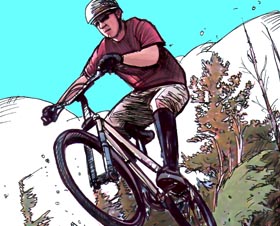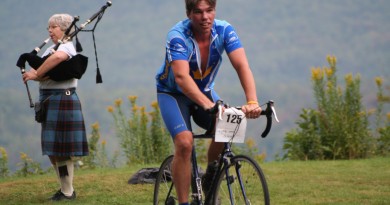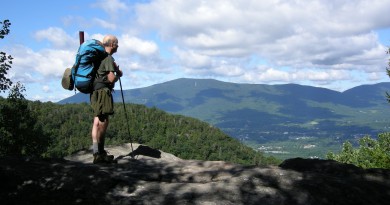Gravity and the Bicycle
By
John Atkinson
Posted August 26th, 2009

Somebody asked me recently, “This downhilling, it’s not real biking, is it?” No, it’s not real, just like lift-served skiing isn’t real skiing. Make sure to tell Bode.
Even if you’re a dyed-in-the-lycra roadie or a goat-climbing cross-country rider who shuns lifts on principal, hopefully you can admit that downhilling, free-riding, pump tracks, and jumps have a universal dirty attraction by being a little scary and decadent. Right? You know it is fun, but can you handle it and still respect yourself in the morning, too?
Of course, you can. And you should.
There is simply no better way to improve dexterity and balancing skills than lots of vertical on dirt. This doesn’t mean that you have jump off a 10-foot drop on your first ride, or ever for that matter. Even the easy trails can be ridden faster to add challenge. Believe it or not, mellower terrain is generally where learning is often best for all abilities.
Many downhills have pedaling potential and learning to spin efficiently on a big travel bike can transfer to big improvements on your more rigid road or cross-country frame. Spinning circles on an energy-soaking suspension makes everything else seem so much easier.
Downhilling also requires constant motion to maintain control, balance, and direction. Only rarely do you sit on the saddle, mainly at rest stops. Power movements from an active core are key, which require standing up and lots of hip movement. Imagine your confidence on the Appalachian Gap or Burning Spear after several hours of non-stop dirt descents.
Pump tracks and dirt jumps require skills that will enhance acceleration techniques through efficient use of terrain. Instead of getting tossed around by bumps and uneven surfaces, you’ll be gaining speed off every little undulation.
Okay, now that you’re convinced, how do you have a positive experience your first time? This seems like a good point to talk about protection. Padding and helmets, that is.
Knee/shin, elbow/forearm, and full-face helmets are pretty much expected for downhilling. Many freeriders and dirt jumpers often wear normal bike lids, although there is no standard. In my opinion, the more padding, the better, including back, chest and shoulder. You may fall, and the padding absorbs a lot of slides and impacts. Ski areas that have downhill bike programs usually rent pads and helmets. Ride smarter, not harder.
Speaking of rentals, leave that old hardtail with the v-brakes at home. Rent a dh/fr rig and discover a whole new world of riding pleasure. You know the difference shaped fat skis have made? Same thing. The wow factor is skyscraping.
You may have been across the country on your road bike or climbed the greasiest Green Mountain gnarl, however, new downhillers should take a clinic to learn proper skills and techniques. A good coach will save you time and pain, while sharing confidence and knowledge. More fun is more fun.
Vermont is rich with gravity terrain, from lift-served at Mount Snow, Killington, and Sugarbush, to locally built runs in Burke and Hinesburg, to the pump tracks and dirt jumps of Stowe. Make sure to visit them this summer and be prepared to be a better rider in no time. Don’t worry about the decadence; you’ll be too busy smiling.
See you at the trailhead!
John is one of the first Whistler Gravity Logic-certified free-ride coaches on the East Coast and works at Sugarbush leading bike clinics and building trails. He also serves on the Mad River Riders and Mad River Path board of directors. He lives in Moretown, but rides all over Vermont. You can reach him at fluff@madriver.com.


